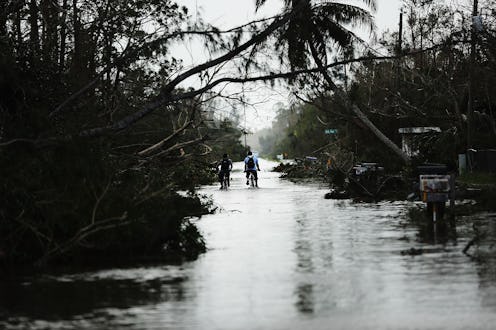Life
The Actual Difference Between A Tropical Storm & Hurricane Is Smaller Than You Think

Tropical Storm Dorian is expected to hit Puerto Rico by Wednesday, according to CBS News — and by that time, it might have turned into a hurricane. This might sound confusing if you don't understand the distinctions between the two. In truth, the difference between a hurricane and a tropical storm is nothing more than a single digit.
Wind speed is actually the only factor separating a tropical storm from a hurricane. For instance, a hurricane has to have sustained winds of 74 MPH or more, and a tropical storm can have sustained winds that are 73 MPH or less, according to the Weather Channel. That's why Dorian is not yet a hurricane.
Per CBS News, the maximum sustained winds recorded for this storm have been around 60 MPH, designating it a tropical storm. Of course, tropical storms can still be extremely dangerous. To put it into perspective, winds of 50-60 MPH are enough to uproot a tree or bring down a power line, according to the National Weather Service.
It's also worth noting that hurricanes and tropical storms are both types of tropical cyclones. Via NASA, tropical cyclones are "non-frontal synoptic scale low-pressure system over tropical or sub-tropical waters with organized [thunderstorm activity] and definite cyclonic surface wind circulation." In other words, hurricanes and tropical storms both have similar structures, in that they both have "eyes" and tend to move in a swirling motion.
It's also worth noting that the only difference between a hurricane, a typhoon, and a cyclone is the location where the storm occurs. If the storm is in the Atlantic and Northeast Pacific, then you call it a hurricane. But if it's in the Northwest Pacific, you call it a typhoon. And if it's in the South Pacific or Indian Ocean, then it's just called a cyclone.
These geographic designations are why news about hurricanes is so common in the United States, and you almost never hear about typhoons or cyclones. And according to the Red Cross, typhoons actually tend to be stronger and to take place more frequently than hurricanes, because of the warmer waters in its geographic location.
However, typhoons also usually cause less damage than hurricanes. This sounds like a paradox, at first. But really, the answer is simple: typhoons cause less damage because they often take place in the middle of the ocean, while hurricanes often hit land.
As for the different categories of hurricanes, those distinctions are also based on the sustained wind speed of the storm. A category 1 hurricane has sustained winds of 74-95 MPH; a category 2 hurricane has sustained winds of 96-110 MPH; a category 3 hurricane has sustained winds of 111-129 MPH; a category 4 hurricane has sustained winds of 130-156 MPH; and a category 5 hurricane has winds of 157 MPH or higher. Category 3 or higher designates the hurricane to be "major," according to the National Hurricane Center, and suggests a higher likelihood of "catastrophic" or "devastating" levels of damage.
If you're concerned about the possibility or likelihood of Tropical Storm Dorian hitting the area where you live, the best thing you can do is stay constantly up to date on the storm's whereabouts and strength. The National Hurricane Center offers a number of tracking options for all hurricanes as they come. You can also check out this article about how to prepare for a hurricane, if you're in the storm's path.